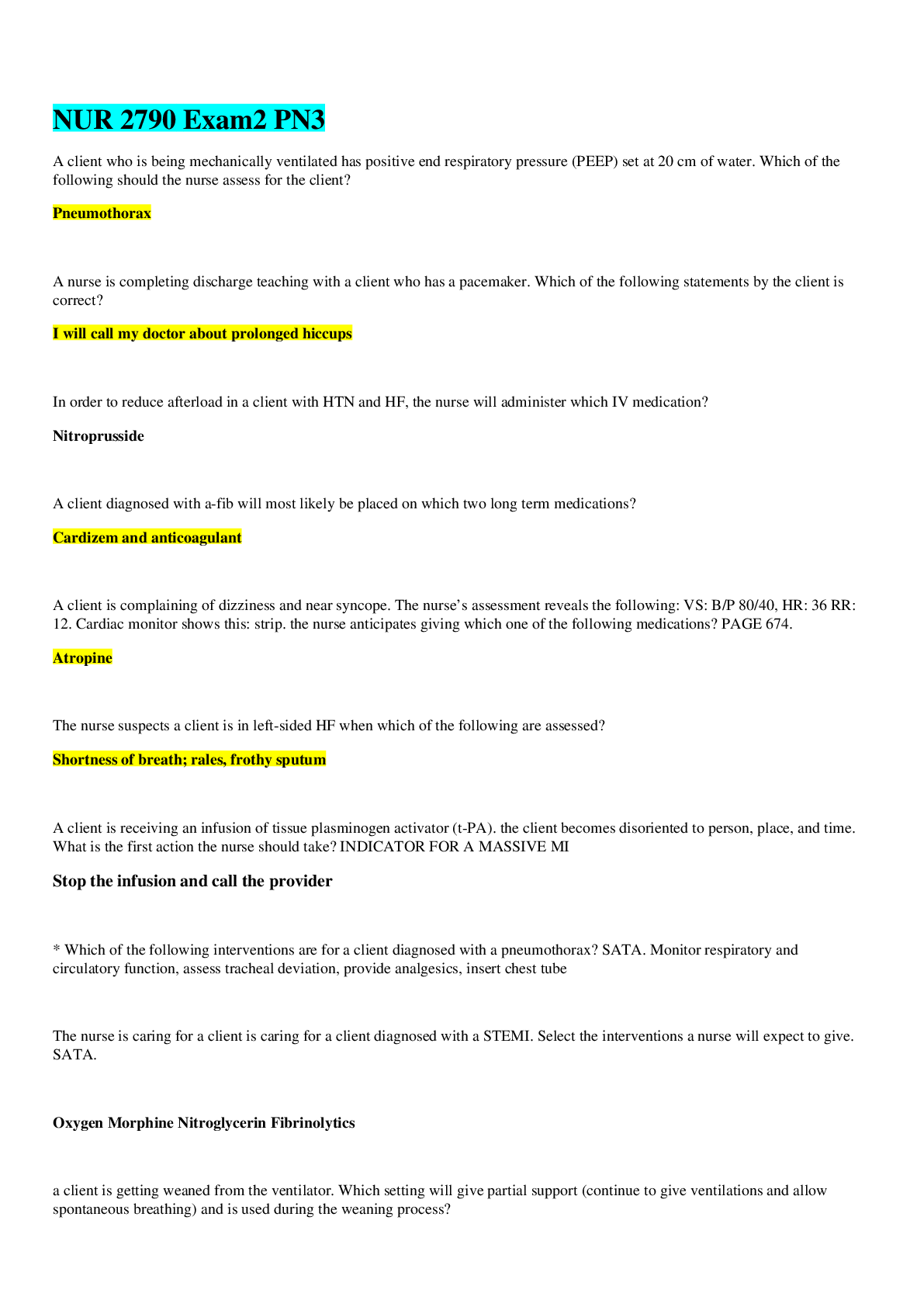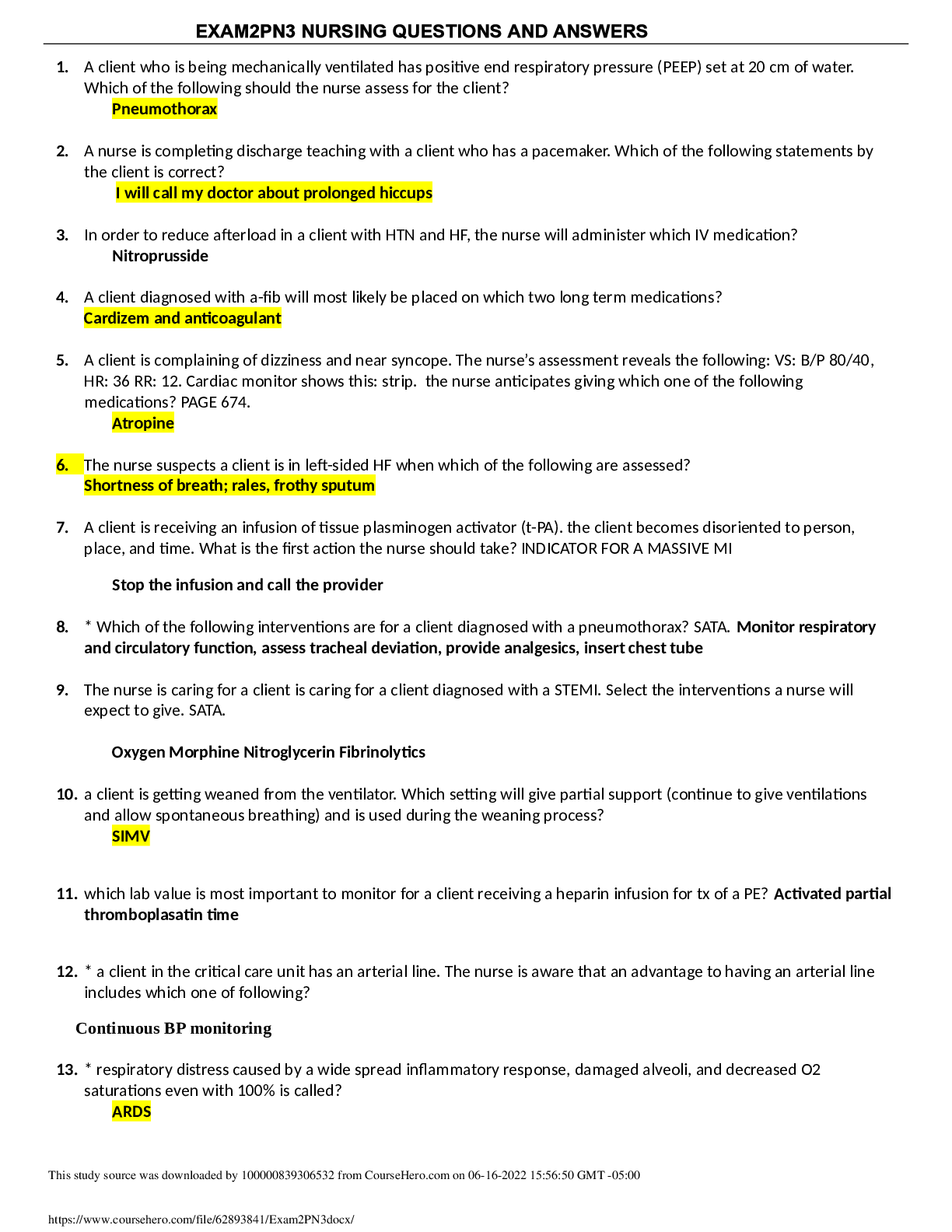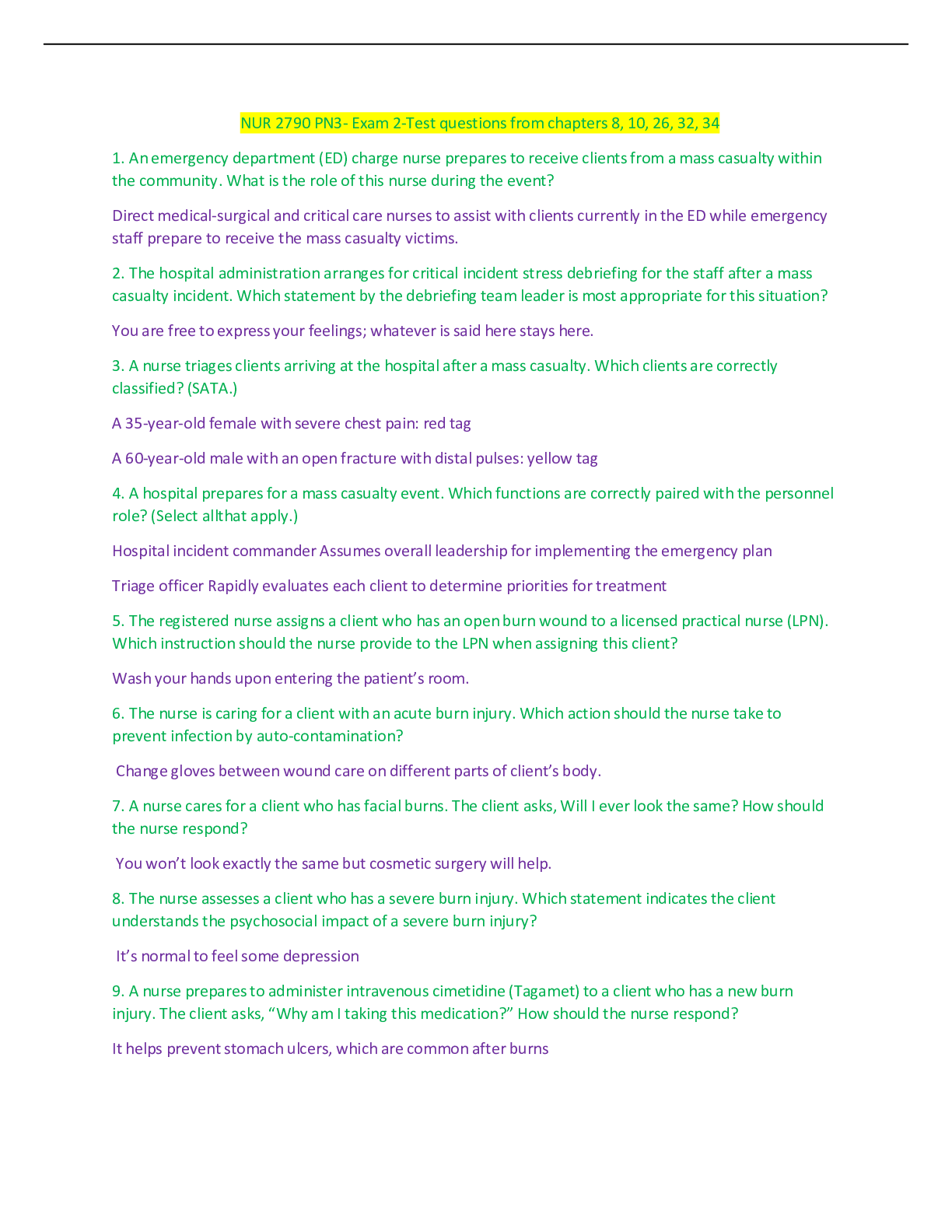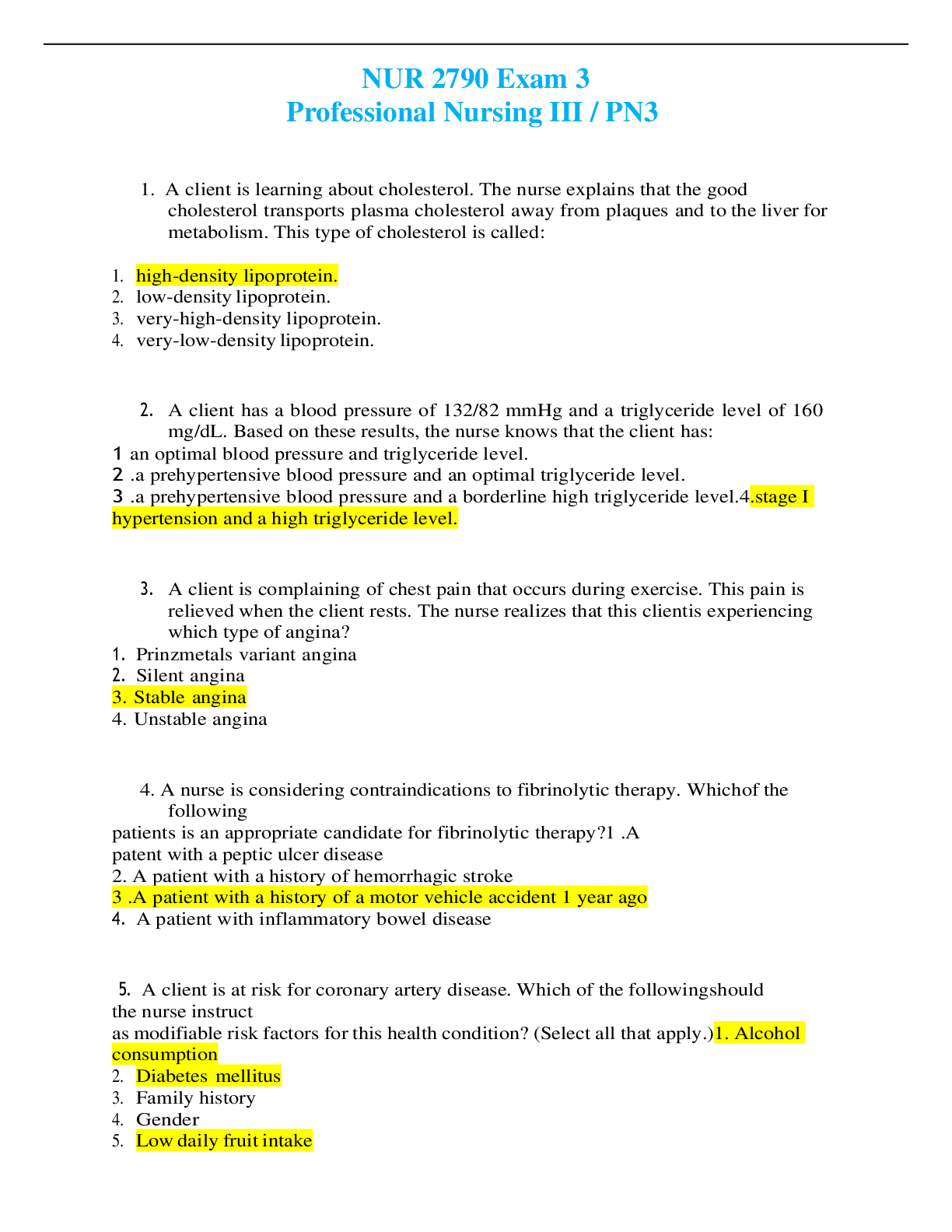Rasmussen College: NUR 2790 Exam 3 RN3_LATEST 2021,100% CORRECT
Document Content and Description Below
Rasmussen College: NUR2790 Exam 3 RN3_LATEST 2021 1. A client is learning about cholesterol. The nurse explains that the good cholesterol transports plasma cholesterol away from plaques and to the li... ver for metabolism. This type of cholesterol is called: 1. high-density lipoprotein. 2. low-density lipoprotein. 3. very-high-density lipoprotein. 4. very-low-density lipoprotein. 2. A client has a blood pressure of 132/82 mmHg and a triglyceride level of 160 mg/dL. Based on these results, the nurse knows that the client has: 1 an optimal blood pressure and triglyceride level. 2 .a prehypertensive blood pressure and an optimal triglyceride level. 3 .a prehypertensive blood pressure and a borderline high triglyceride level. 4.stage I hypertension and a high triglyceride level. 3. A client is complaining of chest pain that occurs during exercise. This pain is relieved when the client rests. The nurse realizes that this client is experiencing which type of angina? 1. Prinzmetals variant angina 2. Silent angina 3. Stable angina 4. Unstable angina 4. A nurse is considering contraindications to fibrinolytic therapy. Which of the following patients is an appropriate candidate for fibrinolytic therapy? 1 .A patent with a peptic ulcer disease 2. A patient with a history of hemorrhagic stroke 3 .A patient with a history of a motor vehicle accident 1 year ago 4. A patient with inflammatory bowel disease 5. A client is at risk for coronary artery disease. Which of the following should the nurse instruct as modifiable risk factors for this health condition? (Select all that apply.) 1. Alcohol consumption 2. Diabetes mellitus 3. Family history 4. Gender 5. Low daily fruit intake 6. Psychosocial index 6. A client is experiencing a sudden onset of chest pain. Which of the following will the nurse do to manage this chest pain? 1. Administer intravenous morphine as prescribed. 2. Provide oxygen. 3. Insert an indwelling urinary catheter. 4. Position the client on the left side. 5. Administer nitroglycerin as prescribed. 6. Administer aspirin as prescribed. 15. The nurse is caring for a client experiencing hypovolemic shock. Which of the following interventions would be appropriate for this client? (Select all that apply.) 1. Monitor intravenous fluid replacement 2. Monitor vital signs 3. Assess for manifestations of fluid overload 4. Monitor white blood cell count and hemoglobin and hematocrit levels 5. Position for comfort 6. Assist to a sitting position 19. A client in shock is apprehensive and slightly confused. What action by the nurse is best? a. Offer to remain with the client for awhile. b. Prepare to administer antianxiety medication. c. Raise all four siderails on the clients bed. d. Tell the client everything possible is being done. 20. A client is in the early stages of shock and is restless. What comfort measures does the nurse delegate to the nursing student? (Select all that apply.) a. Bringing the client warm blankets b. Giving the client hot tea to drink c. Massaging the clients painful legs d. Reorienting the client as needed e. Sitting with the client for reassurance 21. The nurse is caring for a client with suspected severe sepsis. What does the nurse prepare to do within 3 hours of the client being identified as being at risk? (Select all that apply.) a. Administer antibiotics. b. Draw serum lactate levels. c. Infuse vasopressors. d. Measure central venous pressure. e. Obtain blood cultures. 22. A client with severe sepsis has a serum lactate level of 6.2 mmol/L. The client weighs 250 pounds. To infuse the amount of fluid this client requires in 24 hours, at what rate does the nurse set the IV pump? (Record your answer using a whole number.) mL/hr 142 mL/hr 23. What can you do for someone with 80% blockage of coronary artery? balloon, stent, CABG 24. A nurse is caring for four clients. Which client should the nurse assess first? Potassium 3.1mEq/L a. Client with an acute myocardial infarction, pulse 102 beats/min b. Client who is 1 hour post angioplasty, has tongue swelling and anxiety c. Client who is post coronary artery bypass, chest tube drained 100 mL/hr d. Client who is post coronary artery bypass, potassium 4.2 mEq/L 25. A nursing student learns about modifiable risk factors for coronary artery disease. Which factors does this include? (Select all that apply.) a. Age b. Hypertension c. Obesity d. Smoking e. Stress 26. A nurse is caring for a client who had coronary artery bypass grafting yesterday. What actions does the nurse delegate to the unlicensed assistive personnel (UAP)? (Select all that apply.) a. Assist the client to the chair for meals and to the bathroom. b. Encourage the client to use the spirometer every 4 hours. c. Ensure the client wears TED hose or sequential compression devices. d. Have the client rate pain on a 0-to-10 scale and report to the nurse. e. Take and record a full set of vital signs per hospital protocol. 27. A nursing student planning to teach clients about risk factors for coronary artery disease (CAD) would include which topics? (Select all that apply.) a. Advanced age b. Diabetes c. Ethnic background d. Medication use e. Smoking 1. The nurse is analyzing a client’s electrocardiogram tracing and realizes that each small square on the paper is equal to: 0.04 2. The nurse is analyzing a client’s electrocardiogram tracing. Which of the following complexes is not normally seen on an electrocardiogram tracing? U wave 3. A client is experiencing an alteration in heart rate. The nurse realizes this client is experiencing a disorder of which part of the heart? Sinoatrial node. 4. The nurse is reading an ECG rhythm strip and notes that notes that there are nine QRS complexes in a 6-second strip. The heart rate is: 90 5. A client is unresponsive and has no pulse. The nurse notes that the client’s electrocardiogram tracing shows continuous large and bizarre QRS complexes measured greater than 0.12 each. This rhythm is identified as: Ventricular tachycardia 6. A client electrocardiogram tracing shows a sawtooth pattern with F waves. The nurse realizes this client is demonstrating: Atrial flutter 7. Which of the following should the nurse instruct a client who had been diagnosed with an arrhythmia? How to take his own pulse. 8. A client is diagnosed with supraventricular tachycardia. The nurse should prepare to administer which of the following medication? Adenosine 9. A client is recovering form insertion of peacemaker to pace the activity of the ventricles. At which point of the electrocardiogram tracing will the nurse assess pacer spikes? Before the QRS complex. 10. A client with a heart rate if 40 who is experiencing shortness of breath and nausea is diagnosed with second-degree AV block type 11. Which of the following will be included in this client’s treatment? (Select all that apply) (1) Administer atropine sulfate (2) Insert external pacemaker 11. The nurse is assessing a client who is diagnosed with pulseless electrical activity. Which of the following will the nurse include in this assessment? (Select all that apply) (1) Hypovolemia (2) Hypoxia (3) Hypothermia (4) Tamponade (5) Thrombosis 1. The nurse determines that a client’s cardiac output is normal. Which of the following values would be considered normal? 6L/min. 2. The nurse is caring for a client who is experiencing an increase in cardiac contractility. Which of the following will decrease contractility and reduce myocardial oxygen demand for this client? Administer beta-blocker as prescribed. 3. A client is prescribed a vasoactive intravenous medication to maintain a normal blood pressure. Which of the following is not a vasoactive medication? Amiodarone. 1. A client is suspected of having cardiac damage. The nurse realizes that which of the following diagnostic test is most commonly use to help screen a client immediately upon arrival in the ER to determine if the patient is experiencing a STEM? 12-Lead electrocardiogram. 1. A client electrocardiogram rhythm strip is a straight line. Which of the following should the nurse do to help this client? (Select all that apply.) (1) Begin cardiopulmonary resuscitation once verified the client has no pulse (2) Assess for power to the monitor (3) Assess the strip for possible fine ventricular fibrillation (4) Assess for loose leads. 1. A client with a heart rate of 40 who is experiencing shortness of breath and nausea is diagnosed with second-degree AV block type II. Which of the following will be included in this client’s treatment? (Select all that apply.) 1 Administer digoxin . 2 Administer antiemetic . 3 Administer atropine sulfate . 4 Insert external pacemaker . 5 Decrease intravenous fluids . 6 Lower the head of the bed . 2. A client’s electrocardiogram rhythm strip is a straight line. Which of the following should the nurse do to help this client? (Select all that apply.) 1 Assess for loose leads. . 2 Assess for power to the monitor. . 3 Assess the strip for possible fine ventricular fibrillation. . 4 Begin cardiopulmonary resuscitation once verified the client has no pulse. . 5 Raise the head of the bed. . 6 Stop intravenous fluid infusion. . 3. The nurse is assessing a client who is diagnosed with pulseless electrical activity. Which of the following will the nurse include in this assessment? (Select all that apply.) 1 Hypovolemia . 2 Hypoxia . 3 Hypothermia . 4 Tamponade . 5 Thrombosis . 6 Throat pain . 4. Which of the following should be implemented to ensure the safe use of a defibrillator? (Select all that apply.) 1 Do not place over monitoring electrodes. . 2 Do not place over an implanted pacemaker. . 3 Place the paddles at ½ inch from the implanted pacemaker site. . 4 Apply transdermal medication to the chest before using the paddles. . 5 Insert an oral airway before using the paddles. . 6 Have another person hold the client’s airway open while using the paddles. . 5. Which of the following interventions would be appropriate for a client recovering from a pacemaker insertion? (Select all that apply.) 1 Monitor vital signs every 15 minutes until stable. . 2 Assess for chest pain. . 3 Restrict movement of affected extremity. . 4 Monitor electrocardiogram every 8 hours. . 5 Begin intravenous fluid infusion at 150 mL/hr. . 6 Reinforce dressing with excessive bleeding. . A client is determined to not be a candidate for intra-aortic balloon pump monitoring. Which of the following client conditions is the balloon pump contraindicated? (Select all that apply.) 1. Aortic insufficiency 2. Gastric ulcers 3. Dissecting abdominal aortic aneurysm 4. Severe peripheral vascular disease 5. Absent femoral pulses 6. Uncontrolled bleeding A client is suspected of having cardiac damage. The nurse realized that which of the following diagnostic tests is most commonly used to help diagnose this client's possible cardiac damage or disease? 12-lead electrocardiogram The nurse is analyzing a client's ECG tracing. Which of the following complexes is NOT normally seen on an ECG tracing? The U wave A client is unresponsive and has no pulse. The nurse notes that the ECG tracing shows continuous large and bizarre QRS complexes measured greater than 0.12 each. This rhythm is identified as Ventricular Tachycardia An elderly client is demonstrating a change in heart rate that occurs with respiration. When planning care for the client, the nurse knows that treatment may include: pacemaker insertion A clients ECG tracing shows a sawtooth pattern with F waves. The nurse realized this client is demonstrating? atrial flutter Which of the following should the nurse instruct a client who has been diagnosed with an arrhythmia? How to take his own pulse A client is diagnosed with supraventricular tachycardia. The nurse should prepare to administer which of the following meds? Adenosine A client is recovering from insertion of a pacemaker to pace the activity of the ventricles. At which point on the ECG tracing will the nurse assess pacer spikes? Before the QRS A client with a heart rate of 40 who is experiencing shortness of breath and nausea is diagnosed with second degree av-block, type II. Which of the following will be included int his clients treatment? (select all that apply) -Administer atropine sulfate -Insert external pacemaker A client's ECG rhythm strip is a straight line. Which of the following should the nurse do to help the client? (Select all that apply) -assess for loose leads -assess for power to the monitor -assess the strop for possible fine ventricular fibrillation -begin cardiopulmonary resuscitation once verified the client has no pulse The nurse is assessing a client who is diagnosed with pulse-less electrical activity. Which of the following will the nurse include in this assessment? (select all that apply) -hypovolemia -hypoxia -hypothermia -tamponade -thrombosis Which of the following should be implemented to ensure the safe use of a defibrillator? (select all that apply) -do not place over monitoring electrodes -do not place over an implanted pacemaker wotf rhythm will require immediate application of an external pacemaker a sinus bradycardia with bp 70/30 strip during an assessment of a client on a cardiac monitor the nurse observes a change in the client's rhythm identify this rhythm and their appropriate treat strip ventricular fibrillation - defib a nurse is completing discharge teaching to a client who has a permanent pacemaker in the wotf statements by the client is correct i will call my dr about prolonged hiccups Mrs. G is admitted to the critical care unit with and an acute MI her physician orders a lidocaine drip via infusion pump order is lidocaine 1 g in 250ml D5W iv to infuse at 4mg/min what is the infusion rate in ml per/min 1ml/min a client with a hx of dysrhythmias is placed on a cardio monitor the following rhythym is observed the nurse correctly documents it as which rhythm strip a- flutter in order to reduce afterload in a patient with HTN and HF the nurse will administer which IV meds nitroprusside a client is complaining of dizziness and near syncope the nurse finds the following VS bp 86/40 hr rr 12 cardiac monitor shows this rhythm the nurse anticipates giving wotf meds strip atropine the following rhythm is identified on the client’s cardiac monitor what is the 1st action the nurse will take check the client and check the leads a client in the critical care has an arterial line the client is aware that an advantage to having an arterial line includes wotf allows ability to provide continuous bp monitoring Treatment for SVT? Adenosine, cardioversion is adenosine is unsuccessful 6mg, 12mg, 6mg 2nd degree block type 1 Mobitz - QRS, p immediately follows, drops next QRS. pause pars again type 2 p's regular, bust skips a qrs Both = pacemaker, type 1 is vagal stimulation atropine 0.5-1mg Beta Blockers -olol lower blood pressure, help blood vessels open to improve flow SVT and VT Vasoactive Drugs Low BP adrenaline, dopamine, vasopressin, dobutamine What are the hearts natural pacemakers? -SA Node - main pacemaker 60-100BPM -AV Node - if SA fails, 40-60BPM -Ventricles - if AV fails, <40BPM What is cardiac output? -The amount of blood the heart pumps out in a minute. 4-8L/min -SV x HR = CO -SV - stroke volume, ant of blood/beat What does a normal heart rhythm have? -P Wave (SA node firing) -PR Interval (Atrial Depolarization) -QRS Complex (Right Ventricles) (Ventricular Depolarization) -T Wave (Ventricular Repolarization) What are the measurements for normal ECGs? -PR Interval - 0.12-0.2s -QRS <0.12s -P and T Waves should be present, T should be upwards6 ECG boxes Small Box - 0.04sec Large Box - 0.20sec How do you determine the HR on a 6sec strip? -If regular - 1500/time between 2 QRS Complex -If irregular - full QRS x10 V Tach Treatment Amiodarone & Lidocaine Pulseless V Tach Treatment CPR, defib w/ electrical activity Asystole CPR, Epi Difference of defibrillation and cardioversion? -Defib, asynchronous 300-400jules -Cardio, synchronized 50-100 jules, synchs with R AFib and Aflutter difference/treatment -AFib - atria beats irregularly -AFlutter - atria beats regular but faster than normal -Treatment: O2, Anticoags, Cardioversion Atrial Fibrillation Atrial Flutter Saw toothy V Tach V Fib PEA Epi and CPR - treat like asystole [Show More]
Last updated: 1 year ago
Preview 1 out of 23 pages

Reviews( 0 )
Document information
Connected school, study & course
About the document
Uploaded On
Feb 03, 2022
Number of pages
23
Written in
Additional information
This document has been written for:
Uploaded
Feb 03, 2022
Downloads
0
Views
17


















 (1).png)








